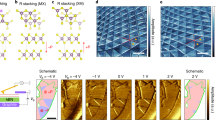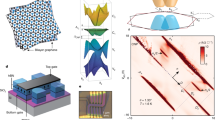Abstract
Perpendicular electric fields can tune the electronic band structure of atomically thin semiconductors. In bilayer graphene, which is an intrinsic zero-gap semiconductor, a perpendicular electric field opens a finite bandgap. So far, however, the same principle could not be applied to control the properties of a broader class of 2D materials because the required electric fields are beyond reach in current devices. To overcome this limitation, we design double ionic gated transistors that enable the application of large electric fields of up to 3 V nm−1. Using such devices, we continuously suppress the bandgap of few-layer semiconducting transition metal dichalcogenides (that is, bilayer to heptalayer WSe2) from 1.6 V to zero. Our results illustrate an excellent level of control of the band structure of 2D semiconductors.
This is a preview of subscription content, access via your institution
Access options
Access Nature and 54 other Nature Portfolio journals
Get Nature+, our best-value online-access subscription
$29.99 / 30 days
cancel any time
Subscribe to this journal
Receive 12 print issues and online access
$259.00 per year
only $21.58 per issue
Buy this article
- Purchase on Springer Link
- Instant access to full article PDF
Prices may be subject to local taxes which are calculated during checkout




Similar content being viewed by others
Data availability
The data that support the findings of this study are available free of charge from the Yareta repository of the University of Geneva at https://doi.org/10.26037/yareta:txap4ayzibcm5hcipvvzufx72a. This repository contains the data presented in all figures, including those in the Supplementary Information.
References
Novoselov, K. S. et al. Two-dimensional atomic crystals. Proc. Natl Acad. Sci. USA 102, 10451–10453 (2005).
Oostinga, J. B., Heersche, H. B., Liu, X., Morpurgo, A. F. & Vandersypen, L. M. K. Gate-induced insulating state in bilayer graphene devices. Nat. Mater. 7, 151–157 (2008).
Zhang, Y. et al. Direct observation of a widely tunable bandgap in bilayer graphene. Nature 459, 820–823 (2009).
Mak, K. F., Lui, C. H., Shan, J. & Heinz, T. F. Observation of an electric-field-induced band gap in bilayer graphene by infrared spectroscopy. Phys. Rev. Lett. 102, 256405 (2009).
Ramasubramaniam, A., Naveh, D. & Towe, E. Tunable band gaps in bilayer transition-metal dichalcogenides. Phys. Rev. B 84, 205325 (2011).
Drummond, N. D., Zólyomi, V. & Fal’ko, V. I. Electrically tunable band gap in silicene. Phys. Rev. B 85, 075423 (2012).
Chu, T., Ilatikhameneh, H., Klimeck, G., Rahman, R. & Chen, Z. Electrically tunable bandgaps in bilayer MoS2. Nano Lett. 15, 8000–8007 (2015).
Kim, J. et al. Observation of tunable band gap and anisotropic Dirac semimetal state in black phosphorus. Science 349, 723–726 (2015).
Dai, X., Li, W., Wang, T., Wang, X. & Zhai, C. Bandstructure modulation of two-dimensional WSe2 by electric field. J. Appl. Phys. 117, 084310 (2015).
Deng, B. et al. Efficient electrical control of thin-film black phosphorus bandgap. Nat. Commun. 8, 14474 (2017).
Overweg, H. et al. Electrostatically induced quantum point contacts in bilayer graphene. Nano Lett. 18, 553–559 (2018).
Chen, P. et al. Band evolution of two-dimensional transition metal dichalcogenides under electric fields. Appl. Phys. Lett. 115, 083104 (2019).
Yuan, H. et al. High-density carrier accumulation in ZnO field-effect transistors gated by electric double layers of ionic liquids. Adv. Funct. Mater. 19, 1046–1053 (2009).
Fujimoto, T. & Awaga, K. Electric-double-layer field-effect transistors with ionic liquids. Phys. Chem. Chem. Phys. 15, 8983–9006 (2013).
Bisri, S. Z., Shimizu, S., Nakano, M. & Iwasa, Y. Endeavor of iontronics: from fundamentals to applications of ion-controlled electronics. Adv. Mater. 29, 1607054 (2017).
Schmidt, E., Shi, S., Ruden, P. P. & Frisbie, C. D. Characterization of the electric double layer formation dynamics of a metal/ionic liquid/metal structure. ACS Appl. Mater. Interfaces 8, 14879–14884 (2016).
Philippi, M., Gutiérrez-Lezama, I., Ubrig, N. & Morpurgo, A. F. Lithium-ion conducting glass ceramics for electrostatic gating. Appl. Phys. Lett. 113, 033502 (2018).
Zhang, H., Berthod, C., Berger, H., Giamarchi, T. & Morpurgo, A. F. Band filling and cross quantum capacitance in ion-gated semiconducting transition metal dichalcogenide monolayers. Nano Lett. 19, 8836–8845 (2019).
Gutiérrez-Lezama, I., Ubrig, N., Ponomarev, E. & Morpurgo, A. F. Ionic gate spectroscopy of 2D semiconductors. Nat. Rev. Phys. 3, 508–519 (2021).
Yamada, Y. et al. Electrically induced ferromagnetism at room temperature in cobalt-doped titanium dioxide. Science 332, 1065–1067 (2011).
Ye, J. T. et al. Superconducting dome in a gate-tuned band insulator. Science 338, 1193–1196 (2012).
Wang, S., Ha, M., Manno, M., Frisbie, C. D. & Leighton, C. Hopping transport and the Hall effect near the insulator–metal transition in electrochemically gated poly(3-hexylthiophene) transistors. Nat. Commun. 3, 1210 (2012).
Lu, J. M. et al. Evidence for two-dimensional Ising superconductivity in gated MoS2. Science 350, 1353–1357 (2015).
Costanzo, D., Jo, S., Berger, H. & Morpurgo, A. F. Gate-induced superconductivity in atomically thin MoS2 crystals. Nat. Nanotechnol. 11, 339–344 (2016).
Leighton, C. Electrolyte-based ionic control of functional oxides. Nat. Mater. 18, 13–18 (2019).
Ponomarev, E., Ubrig, N., Gutiérrez-Lezama, I., Berger, H. & Morpurgo, A. F. Semiconducting van der Waals interfaces as artificial semiconductors. Nano Lett. 18, 5146–5152 (2018).
Reddy, B. A. et al. Synthetic semimetals with van der Waals interfaces. Nano Lett. 20, 1322–1328 (2020).
Alam, M. H. et al. Lithium-ion electrolytic substrates for sub-1V high-performance transition metal dichalcogenide transistors and amplifiers. Nat. Commun. 11, 3203 (2020).
Nakajima, K., Katoh, T., Inda, Y. & Hoffman, B. Lithium Ion Conductive Glass Ceramics: Properties and Application in Lithium Metal Batteries (Ohara Corporation, 2010); http://oharacorp.com/pdf/ohara-presentation-ornl-symposium-10-08-2010.pdf
Zheliuk, O. et al. Josephson coupled Ising pairing induced in suspended MoS2 bilayers by double-side ionic gating. Nat. Nanotechnol. 14, 1123–1128 (2019).
Ji, H. et al. Thickness effect on low-power driving of MoS2 transistors in balanced double-gate fields. Nanotechnology 31, 255201 (2020).
Wang, Y. et al. Structural phase transition in monolayer MoTe2 driven by electrostatic doping. Nature 550, 487–491 (2017).
Zhang, F. et al. Electric-field induced structural transition in vertical MoTe2- and Mo1−xWxTe2-based resistive memories. Nat. Mater. 18, 55–61 (2019).
Qian, X., Liu, J., Fu, L. & Li, J. Quantum spin Hall effect in two-dimensional transition metal dichalcogenides. Science 346, 1344–1347 (2014).
Tong, Q. et al. Topological mosaics in moiré superlattices of van der Waals heterobilayers. Nat. Phys. 13, 356–362 (2017).
Zhu, Q., Tu, M. W.-Y., Tong, Q. & Yao, W. Gate tuning from exciton superfluid to quantum anomalous Hall in van der Waals heterobilayer. Sci. Adv. 5, eaau6120 (2019).
Marrazzo, A., Gibertini, M., Campi, D., Mounet, N. & Marzari, N. Prediction of a large-gap and switchable Kane–Mele quantum spin Hall insulator. Phys. Rev. Lett. 120, 117701 (2018).
Kim, D., Lee, C., Jang, B. G., Kim, K. & Shim, J. H. Drastic change of magnetic anisotropy in Fe3GeTe2 and Fe4GeTe2 monolayers under electric field studied by density functional theory. Sci. Rep. 11, 17567 (2021).
Xu, C. et al. Electric-field switching of magnetic topological charge in type-I multiferroics. Phys. Rev. Lett. 125, 037203 (2020).
Wang, S. et al. Tunable Schottky barrier in graphene/graphene-like germanium carbide van der Waals heterostructure. Sci. Rep. 9, 5208 (2019).
Wang, J. et al. Electric field-tunable structural phase transitions in monolayer tellurium. ACS Omega 5, 18213–18217 (2020).
Ke, C. et al. Tuning the electronic, optical, and magnetic properties of monolayer GaSe with a vertical electric field. Phys. Rev. Appl. 9, 044029 (2018).
Weintrub, B. I., Hsieh, Y.-L., Kirchhof, J. N. & Bolotin, K. I. Generating extreme electric fields in 2D materials by dual ionic gating. Preprint at https://arxiv.org/abs/2108.05797 (2021).
Zomer, P. J., Guimarães, M. H. D., Brant, J. C., Tombros, N. & van Wees, B. J. Fast pick up technique for high quality heterostructures of bilayer graphene and hexagonal boron nitride. Appl. Phys. Lett. 105, 013101 (2014).
Domaretskiy, D., Ubrig, N., Gutiérrez-Lezama, I., Tran, M. K. & Morpurgo, A. F. Identifying atomically thin crystals with diffusively reflected light. 2D Mater. 8, 045016 (2021).
Perdew, J. P., Burke, K. & Ernzerhof, M. Generalized gradient approximation made simple. Phys. Rev. Lett. 77, 3865–3868 (1996).
Giannozzi, P. et al. QUANTUM ESPRESSO: a modular and open-source software project for quantum simulations of materials. J. Phys. Condens. Matter 21, 395502 (2009).
Giannozzi, P. et al. Advanced capabilities for materials modelling with QUANTUM ESPRESSO. J. Phys. Condens. Matter 29, 465901 (2017).
Hamann, D. R. Optimized norm-conserving Vanderbilt pseudopotentials. Phys. Rev. B 88, 085117 (2013).
van Setten, M. J. et al. The PseudoDojo: training and grading a 85 element optimized norm-conserving pseudopotential table. Comput. Phys. Commun. 226, 39–54 (2018).
Sohier, T., Calandra, M. & Mauri, F. Density functional perturbation theory for gated two-dimensional heterostructures: theoretical developments and application to flexural phonons in graphene. Phys. Rev. B 96, 075448 (2017).
Pizzi, G. et al. Wannier90 as a community code: new features and applications. J. Phys. Condens. Matter 32, 165902 (2020).
Acknowledgements
The authors thank A. Ferreira for technical support. A.F.M. acknowledges financial support from the Swiss National Science Foundation (Division II) and from the EU Graphene Flagship project. M.G. acknowledges support from the Italian Ministry for University and Research through the Levi-Montalcini programme.
Author information
Authors and Affiliations
Contributions
D.D., M.P., N.U. and I.G.-L. fabricated the devices and carried out the experiments. D.D., M.P., I.G.-L. and A.F.M. analysed the experimental data. M.G. performed the first-principles simulations. I.G.-L. supervised the experimental work, and A.F.M. conceived and directed the research. All authors participated in preparing the manuscript.
Corresponding author
Ethics declarations
Competing interests
The authors declare no competing interests.
Peer review
Peer review information
Nature Nanotechnology thanks the anonymous reviewers for their contribution to the peer review of this work.
Additional information
Publisher’s note Springer Nature remains neutral with regard to jurisdictional claims in published maps and institutional affiliations.
Supplementary information
Supplementary information
Supplementary Notes 1–8 and Figs. 1–13.
Rights and permissions
About this article
Cite this article
Domaretskiy, D., Philippi, M., Gibertini, M. et al. Quenching the bandgap of two-dimensional semiconductors with a perpendicular electric field. Nat. Nanotechnol. 17, 1078–1083 (2022). https://doi.org/10.1038/s41565-022-01183-4
Received:
Accepted:
Published:
Issue Date:
DOI: https://doi.org/10.1038/s41565-022-01183-4
This article is cited by
-
Resonant exciton transfer in mixed-dimensional heterostructures for overcoming dimensional restrictions in optical processes
Nature Communications (2023)
-
Generating intense electric fields in 2D materials by dual ionic gating
Nature Communications (2022)



